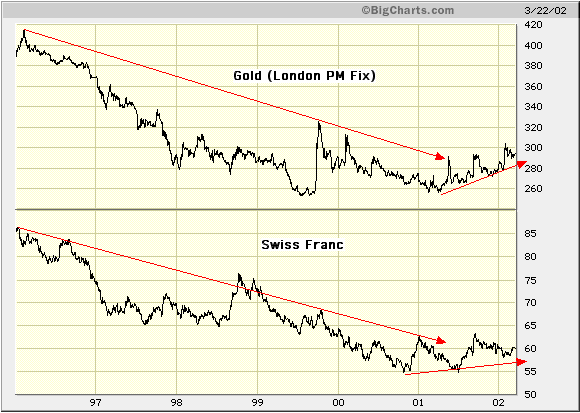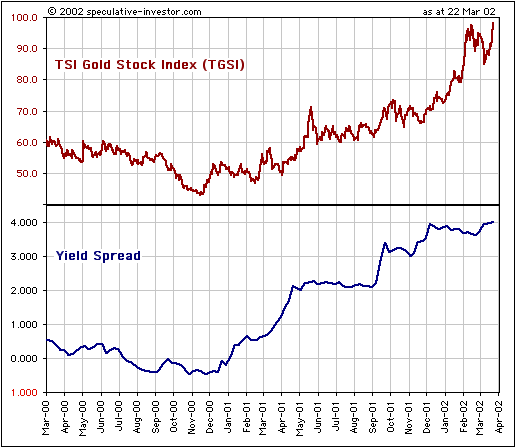
What drives
the prices of gold and gold stocks?
The following is an extract from
commentary that was posted at www.speculative-investor.com on 24th March
2002,
There is a great deal of misinformation
floating around regarding what causes the gold price to rise and fall,
some of it deliberate and some of it unintentional. Most of the unintentional
misinformation seems to stem from a failure to recognise that the gold
market cannot be analysed in the same way as other commodity markets and
from a failure to differentiate short-term influences from longer-term
influences. Below is our attempt to briefly describe the most important
short, medium and long-term drivers of the prices of gold and gold stocks.
The most important driver of the gold
price in both the medium and the long-term is the trend in the US$ relative
to the other major currencies. Since the official link between gold and
the Dollar was broken in 1971 the primary trends in the US$ and the gold
price have invariably been in opposite directions. However, rather than
looking at the gold price relative to the Dollar Index we prefer to monitor
this powerful long-term relationship by looking at the US$ gold price relative
to the Swiss Franc. We do this because the SF is the currency with the
highest positive correlation to the gold price.
The below chart illustrates the positive
correlation between the longer-term trends in the SF and the gold price
(the chart begins in 1996 but the same correlation is evident going all
the way back to 1971). It is notable that the gold price has been stronger
than the SF during recent years. This is normal - in a gold bull market
the gold price rises in terms of all currencies.

Interest-rate trends also exert a strong
influence on gold and gold stocks over the medium-term with the influence
often being more readily apparent on the quick-to-respond gold stocks than
on the much larger and more liquid bullion market. Over the past 18 months
we've focused mostly on the relationship between the yield spread (30-year
interest rates minus 13-week interest rates) and gold-stock prices because
the positive correlation between the two has been very strong, as evidenced
by the following chart. As has been the case with all significant up-moves
in gold stock prices since November-2000, last week's surge to new highs
by the TSI Gold Stock Index was preceded by an upturn in the yield spread.

In the short-term the major influences
on the gold market can vary from one week to the next and can range from
selling by the banking community specifically designed to suppress the
gold price, to news/propaganda, to the medium/long-term influences mentioned
above. The most important short-term influence on the gold price since
last September has been the Japanese stock market. In fact, all the financial
markets presently seem to be keying-off what is happening in Japan. Below
is a look at the Nikkei-gold relationship since 1st September 2001.
Since last September the inverse correlation
between the Nikkei and the gold price has been so strong that someone looking
at only the short-term fluctuations in the various markets would probably
jump to the completely-wrong conclusion that the gold price and the US$
were positively correlated. This is because a rising Nikkei (and, therefore,
a falling gold price) has tended to go hand-in-hand with a falling US$,
and vice versa.
The above is our attempt to cover a
few of today's most important influences on the prices of gold and gold
stocks, not all the influences. However, two things that are often cited
as important influences on the gold price that were deliberately omitted
were a) the deficit between new mine supply and fabrication demand, and
b) the general commodity price trend.
The supposed supply deficit was omitted
for two reasons. Firstly, the supply of gold is the approximately 130,000
tonnes of aboveground stock, not the 2,500 tonnes or so per annum of new
mine supply. This aboveground supply results from the fact that gold is
accumulated, not consumed, and means that gold must be analysed in the
same way that we analyse other forms of money, not in the way we analyse
commodity markets. Secondly, the deficit between new mine supply and fabrication
demand tends to follow the gold price rather than being a driver
of the gold price (a fall in the gold price causes fabrication demand to
increase while a rise in the gold price causes it to fall).
The general commodity-price trend was
omitted because we do not think there is a causal relationship between
other commodity prices and the gold price. Sometimes they move in the same
direction while at other times they move in opposite directions, usually
depending on what is happening at the time in the currency market. For
example, in an environment where commodity prices are rising due to a weakening
US$ it is likely that the gold price will also be rising, creating a coincidental
positive correlation between the two.
Over the past 3 years the US$ has generally
been firm and the gold price has, more often than not, moved inversely
to the general commodity price level. Commodity prices have, in recent
years, been moving in-synch with the overall stock market (as represented
by the S&P500) and changes in economic growth expectations - as the
economic outlook has deteriorated or improved, commodity prices have correspondingly
fallen or risen. The gold price, however, has tended to move in the opposite
direction to significant changes in the general outlook for economic growth.
Later this year we expect to see gold and the CRB Index marching higher
together as they both respond to a substantial decline in the US$.
Regular financial market forecasts
and
analyses are provided at our web site:
http://www.speculative-investor.com/new/index.html
One-month free trial available.

|

